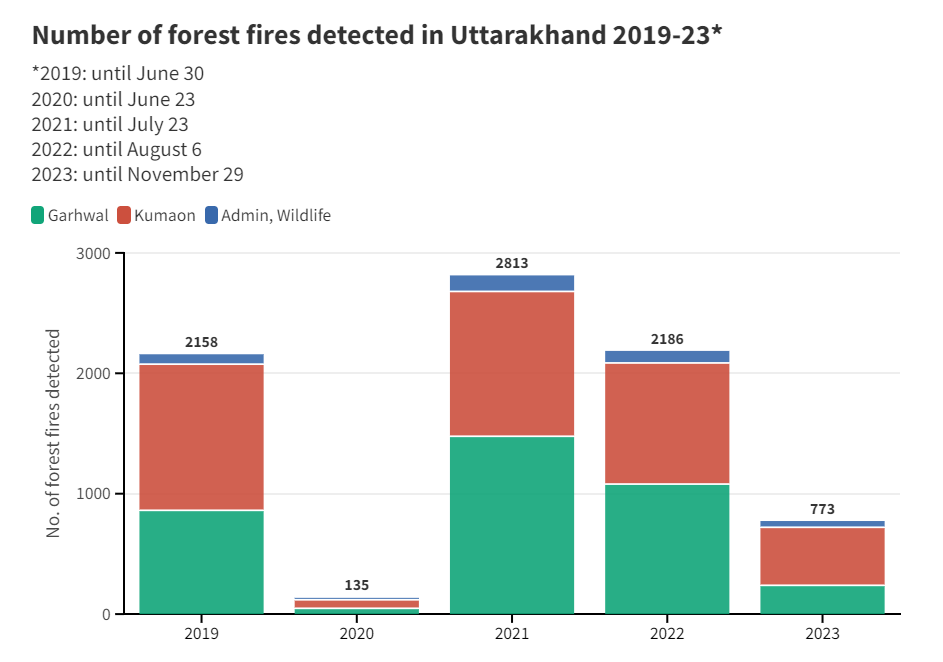Uttarakhand
Nainital Forest Fire
- 29 Apr 2024
- 5 min read
Why in News?
A large wildfire was spread across the forests near Nainital in Uttarakhand. The crisis prompted the Indian Air Force to dispatch personnel and Mi-17 helicopters to help control the intense blaze.
- The fire has allegedly destroyed 108 hectares of forests.
Key Points
- The helicopters are gathering water and using jet-sprays to extinguish the fire in what is known as the Bambi Bucket operation.
- According to the Uttarakhand’s Forest Department, 26 incidents of forest fire occurred in the State’s Kumaon region in a few hours.
- While five incidents occurred in Garhwal region, where 33.34 hectares of forest area was affected.
- As per a 2019 report from the Forest Research Institute (Dehradun), which comes under the Environment Ministry of India, 95% of forest fires are caused by humans.
- There are four forest-fire clusters in India: the North-Western Himalayas, North-East India, Central Ghats, and Western and Eastern Ghats.
- Fires in the North-Western Himalayas are attributed to the preponderance of pine trees and the accumulation of thick flammable litter.
- In the summer, there is a large quantity of pine needles that gather on the forest floor, which is highly susceptible to fire.
Bambi Bucket operation
- The Bambi Bucket, also called a helicopter bucket or a helibucket, is a specialised container that is suspended by cable under a chopper, and which can be filled by lowering into a river or pond before being flown above a fire and discharged aerially by opening a valve at the bottom of the bucket.
- The Bambi Bucket is especially helpful in fighting wildfires that are difficult or impossible to reach from the ground. Around the world, helicopters are frequently commissioned to fight forest fires.
Forest Fire
- Also called bush or vegetation fire or wildfire, it can be described as any uncontrolled and non-prescribed combustion or burning of plants in a natural setting such as a forest, grassland, brushland or tundra, which consumes the natural fuels and spreads based on environmental conditions (e.g., wind, topography).
- A wildfire requires three essential elements to sustain combustion like Fuel, Oxygen, and a Heat source.
- Classification:
- Surface Fire: A forest fire may burn primarily as a surface fire, spreading along the ground as the surface litter (senescent leaves and twigs and dry grasses etc) on the forest floor and is engulfed by the spreading flames.
- Underground Fire/Zombie Fire: The fires of low intensity, consuming the organic matter beneath and the surface litter of the forest floor are sub-grouped as underground fires. In most of the dense forests, a thick mantle of organic matter is found on top of the mineral soil.
- These fires usually spread entirely underground and burn for some meters below the surface.
- This fire spreads very slowly and in most cases it becomes very hard to detect and control such types of fires.
- They may continue to burn for months and destroy the vegetative cover of the soil.
- Canopy or Crown Fires: These occur when fire spreads through the upper canopy of trees, often fueled by high winds and dry conditions. They can be particularly intense and difficult to control.
- Controlled Deliberate Fires: In some cases, controlled deliberate fires, also known as prescribed burns or bushfires, are intentionally set by forest management agencies to reduce fuel loads, mitigate the risk of uncontrolled wildfires, and promote ecosystem health.
- These controlled burns are carefully planned and executed under specific conditions to minimize risks and maximize benefits to the forest ecosystem.








